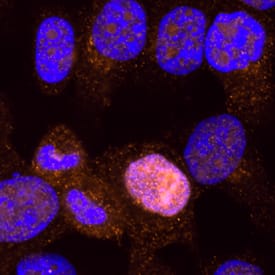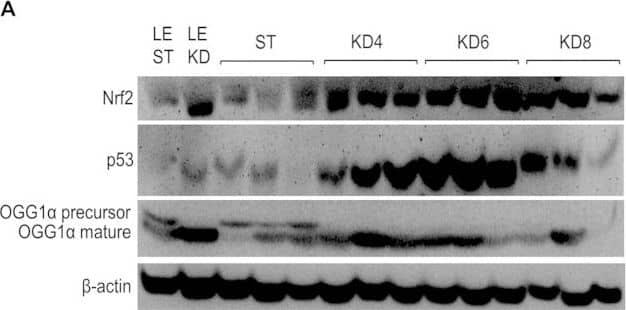Human/Mouse/Rat p53 Antibody
R&D Systems, part of Bio-Techne | Catalog # MAB1355

Key Product Details
Validated by
Species Reactivity
Validated:
Cited:
Applications
Validated:
Cited:
Label
Antibody Source
Product Specifications
Immunogen
Asp7-Asp393
Accession # P04637
Specificity
Clonality
Host
Isotype
Scientific Data Images for Human/Mouse/Rat p53 Antibody
Detection of Human p53 by Western Blot.
Western blot shows lysates of MCF-7 human breast cancer cell line mock-treated (-) or treated (+) with 1 µM camptothecin (CPT) for 1 hour. Human p53 was immunoprecipitated using Mouse Anti-Human/Mouse/Rat p53 Monoclonal Antibody (Catalog # MAB1355). PVDF membrane was probed with HRP-conjugated Anti-Human/Mouse/Rat Polyclonal Antibody (Catalog # HAF1355). A specific band for p53 was detected at approximately 53 kDa (as indicated). This experiment was conducted under reducing conditions and using Immunoblot Buffer Group 1.p53 in HeLa Human Cell Line.
p53 was detected in immersion fixed HeLa human cervical epithelial carcinoma cell line using Mouse Anti-Human/Mouse/Rat p53 Monoclonal Antibody (Catalog # MAB1355) at 3 µg/mL for 3 hours at room temperature. Cells were stained using the NorthernLights™ 557-conjugated Anti-Mouse IgG Secondary Antibody (red; Catalog # NL007) and counterstained with DAPI (blue). Specific staining was localized to cytoplasm and nuclei. View our protocol for Fluorescent ICC Staining of Cells on Coverslips.Detection of Rat p53 by Western Blot
Immunoblot analysis of kidney lysates.(A) Blot membranes were incubated with the antibodies against Nrf2, p53 and 8-oxoguanine glycosylase alpha (OGG1 alpha). The mean integrated optical density is related to actin for Nrf2 (B), p53 (C) and mature 8-oxoguanine glycosylase alpha (D) levels. Results are given as a mean ± S.E.M. KD4, KD6, KD8 – groups of Eker rats (Tsc2+/−) treated with HFKD for four, six or eight mo., respectively; ST – Eker rats fed with a standard diet; LE ST – wild-type Long Evans rats treated with a standard diet; LE KD – wild-type Long Evans rats treated with a ketogenic diet similarly to the KD6 group. *P < 0.05, **p < 0.01, ***p < 0.001 as compared to ST unless otherwise stated (horizontal line) for ANOVA with a Fisher post hoc test. Image collected and cropped by CiteAb from the following publication (https://pubmed.ncbi.nlm.nih.gov/26892894), licensed under a CC-BY license. Not internally tested by R&D Systems.Applications for Human/Mouse/Rat p53 Antibody
Immunocytochemistry
Sample: Immersion fixed HeLa human cervical epithelial carcinoma cell line
Immunoprecipitation
Sample: CEM human T-lymphoblastoid cell line, see our available Western blot detection antibodies
Western Blot
Sample: p53 immunoprecipitated from lysates of MCF-7 human breast cancer cell line using anti-P53 monoclonal antibody???
Reviewed Applications
Read 1 review rated 5 using MAB1355 in the following applications:
Formulation, Preparation, and Storage
Purification
Reconstitution
Formulation
Shipping
Stability & Storage
- 12 months from date of receipt, -20 to -70 °C as supplied.
- 1 month, 2 to 8 °C under sterile conditions after reconstitution.
- 6 months, -20 to -70 °C under sterile conditions after reconstitution.
Background: p53
The p53 tumor suppressor protein is a multi-functional transcription factor that regulates cellular decisions regarding proliferation, cell cycle checkpoints, and apoptosis. The importance of p53 is underscored by its mutation in over 50% of human cancers. Mice that lack one or both copies of p53 also showed an increased incidence of tumors, which makes the p53 deficient mouse a model system for studying cancer generation and progression.
Alternate Names
Gene Symbol
UniProt
Additional p53 Products
Product Documents for Human/Mouse/Rat p53 Antibody
Product Specific Notices for Human/Mouse/Rat p53 Antibody
For research use only


